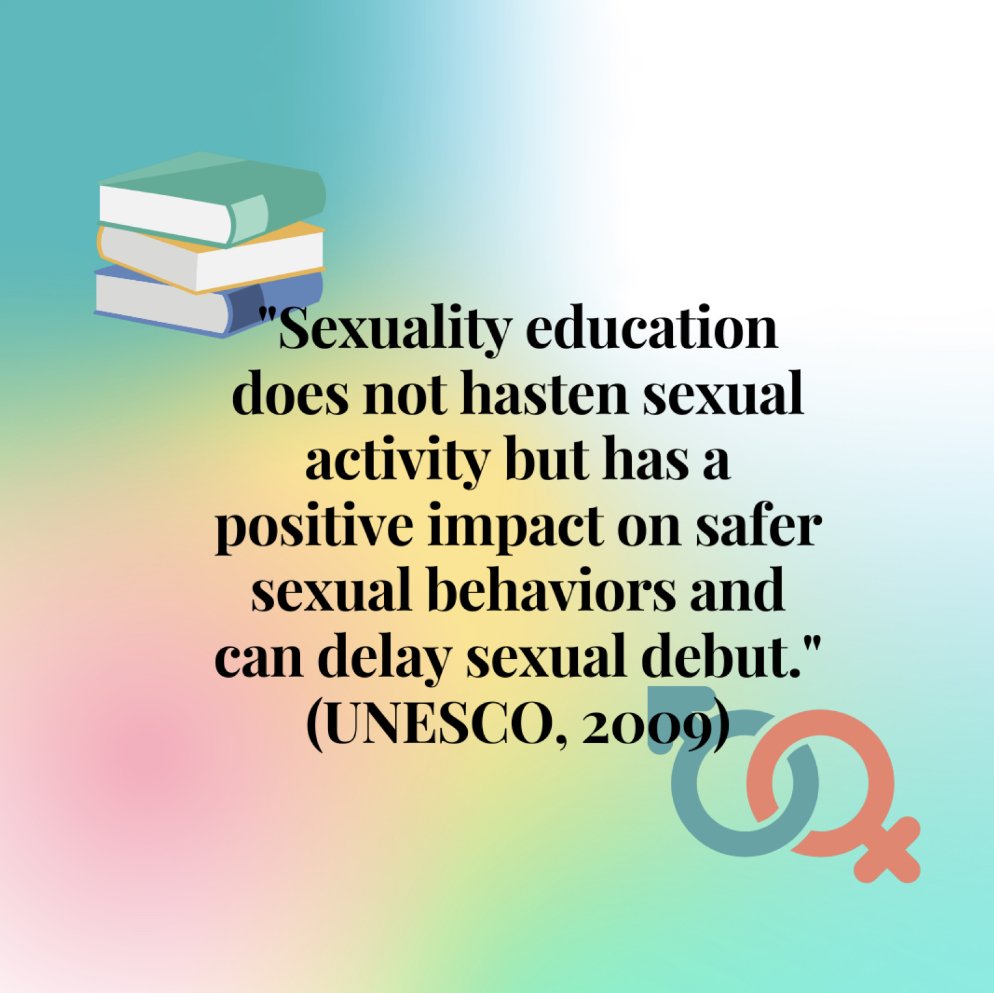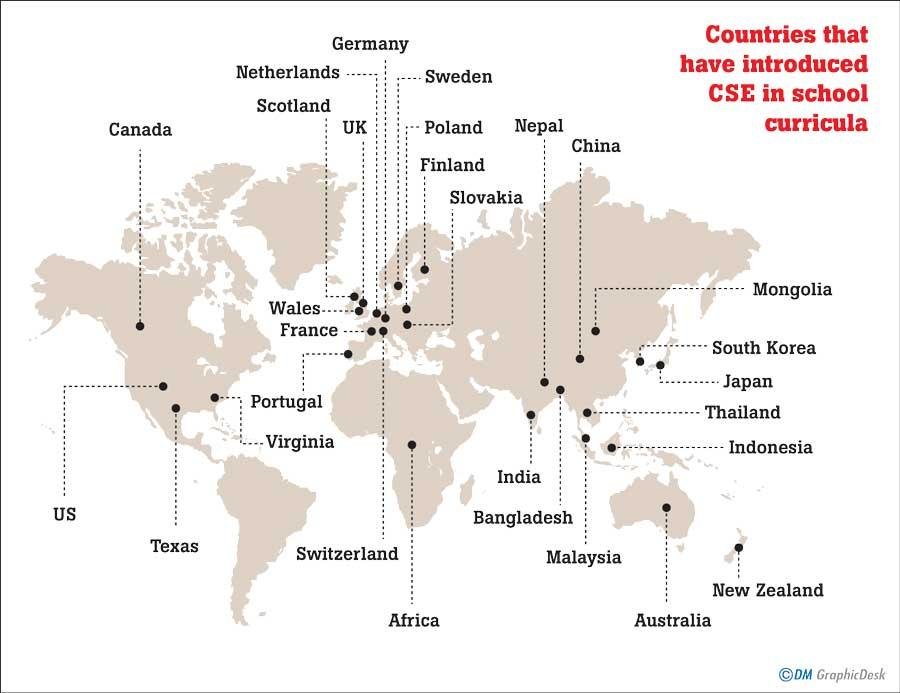Sexual Education: A handbook for sex or a necessity?
Author: Ashwini Karunathilaka
Editor: Elisah Sauerbier, Anastasia Pinkse, Kintan van Leeuwen
According to the World Health Organization (WHO), Sexual Education (Sex Ed) refers to “learning about the cognitive, emotional, socially interactive and physical aspects of sexuality”. The term was first coined in Sweden, in 1955 and since then it has evolved and developed with the growing, fast-paced world. However, the main basis behind implementing Sex Ed as part of the curriculum has remained consistent. The aim is to provide children with the necessary knowledge, skills, attitudes, and values about sexual intercourse and sexual relations and thereby promoting their sexual health and well-being.
The importance of sexual education has changed with time as it started with the goal of preventing unwanted pregnancies. Then the importance expanded to the prevention of sexually transmitted diseases (STDs) such as HIV and raising awareness about sexual abuse. Finally, from the year 2000 onwards the focus has been redirected to preventing sexism, homophobia, and online bullying (European Expert Group on Sexuality Education, 2016).
Sexual and Reproductive Health (SRH)
There are key sexual and reproductive issues that affect young people today. Firstly, the transition from childhood to adulthood known as “puberty” is a challenging period for both boys and girls. Therefore, being taught about both the physical and psychological changes one might face during puberty is vital in creating a generation that is highly knowledgeable and competent to deal with these changes. Secondly, early pregnancies and childbirth have both health and social repercussions among girls. WHO states that complication during pregnancy is one of the biggest causes of death among adolescents (WHO, 2011, as cited in UNESCO, 2018). This also has social consequences because young girls are most likely asked to drop out of school, which puts a pause on their education and employment opportunities in the future. The lack of access to modern contraception is another major barrier that both females and males face. Amongst that, the lack of education on contraceptives, their side effects, and legal barriers result in unwanted pregnancies and increase the chances of sexually transmitted diseases.
Source: Sri Lanka UNFPA
HIV and AIDS still prevail in today’s modern world and despite the progress society has made over the years, only 36% of young men and 30% of young women have access to scientifically proven methods of how to prevent HIV (UNFPA, 2018). In addition, most education systems are not inclusive of the LGBTQI+ community, therefore, the lack of awareness and resources neglect this community and creates an information gap.
Finally, the percentage of violence and specifically gender-based violence is higher than ever.
1 in 3 women in the world has experienced physical or sexual abuse in their lifetime (UNESCO, 2018). Intimate partner violence, child sexual abuse, forced intercourse or sexual acts, child marriages, and female genital mutilation/cutting are still at large and directly affect one’s emotional and sexual well-being. These are some of the issues addressed in Sex Ed. By educating and engaging in conversation about these issues, a lot of people would thereby be able to safeguard their sexual and emotional condition, signal these issues and spread awareness about the consequences.
How important is sex education?
Sexual education was built on upholding the rights of children, but of young adults and humans in general, regarding health, education, information equality, and non-discrimination. Therefore, the importance of Sex Ed stems from promoting and understanding universal human rights.
Lack of education contributes to the disparity between children and young adults today. It regulates misinformation among the population and leaves room for sexual myths to arise, therefore, raising awareness is at the centre of eradicating this problem. Educating children and young people gives them the right resources to be assertive in their relationships and communicate effectively, without neglecting their rights. It is proven that Sex Ed teaches young people to set clear, cut boundaries to foster respectful and healthy relationships with family members, romantic or sexual partners, and friends. It helps develop their self-esteem, thereby allowing them to make informed decisions concerning their sexual well-being.
Source: scottscoop
Furthermore, implementing a strong sex education within schools can help challenge the social norms and gender inequality that influences our outlook on sexual behaviour. Patriarchal views govern our society and undermine women in both cultural traditions and sexual scripts. Male sexual script theory strengthens the ideology that men have strong sexual desires and are highly dominating as opposed to women. This traditional way of thinking has detrimental impacts on both women’s and men’s sexual health and well-being. As a result of the predominance of the male sexual script theory, women lack the empowerment they need to set healthy boundaries. Resulting in a negative relationship with sex, having decreased sexual satisfaction, and being more likely to be forced to have sex. This stems from a lack of empowerment given to women. In addition to that, boys who adopt a masculine-dominated belief tend to have more sexual partners and engage in risky sex (for example unsafe sex, without the use of a condom) due to pressure from their peers to act a certain way. This directly targets the issues being addressed by Sex Ed and further confirms how important it is to teach kids at a young age about these damaging stereotypes. Well-informed and age-appropriate sexual education can help foster mutually consensual and respectful relationships.
This shows that Sex Ed is not merely about “sex”, it’s also about promoting respect and teaching children that consent matters and nobody is entitled to make use of their body.
Debunking Myths about Sexual Education
Since the first intervention in Sweden, there have been several myths surrounding Sex Ed. The main one is that it leads young people to have sex earlier in their life, however, research shows that it can delay sexual debut while also encouraging responsible sexual behaviour (Ramírez-Villalobos et al.,2021). Another myth is that Sex Ed strips a child of their innocence. This is the main reason why there is an emphasis on “age-appropriate” sexual education, therefore, relevant topics are discussed at the pace of a child’s growth. A carefully curated Sex Ed curriculum that is scientifically accurate and non-judgemental can help children be aware and recognize the right principles to steer their social relationships and also help them recognize abusive people and situations.
Myths often tend to negatively steer societal beliefs resulting in a circulation of misinformation within communities and in most cases, the decision to implement Sex Ed within schools comes down to the views and opinions of the majority. Therefore, the myths around Sex Ed prevent children from getting the right education and can actually be harmful in the future.
Scope of the problem in Sri Lanka
Since the establishment of Little Leaders Foundation in 2018, we have been committed to fulfilling children’s rights concerning education. Currently, we are executing education-related projects in Sri Lanka and have noticed the lack of Sex Ed within school curriculums.
Source: Dailymirror lk
The Family Bureau of Sri Lanka conducted a study in 2013 that reported that 50% of young people in Sri Lanka have only limited knowledge about sexual reproduction (UNFPA, 2019). This is alarming, as the study shows how unequipped children and young people are in Sri Lanka. Upon questioning, only 35% of girls knew that condoms prevent pregnancies and over 40% of adolescent boys believe that having wet dreams are signs of abnormality.
Sri Lanka is a country enriched with its long-standing cultural values, but the same traditional opinions dictate whether or not Sex Ed is vital in schools. Given the conservative nature, it is no surprise that topics regarding sexual matters are often considered to be taboo. Therefore, many local schools tend to skip biology lessons or conduct the classes in a haste to avoid embarrassment. Due to the lack of foundation being given to students, children get curious about such topics and turn to pornography, magazines, and other sources to get information. These kinds of platforms, however, depict a negative attitude towards sexual activity and behaviour. As this becomes their only source of information about sexual activity, it influences young people gravely.
The current situation in Sri Lanka is generalizable to many other countries that are lacking Sex Ed, as a result of cultural stigma, traditions and morality.
Overall, countries need to evaluate the situation surrounding Sex Ed and not let moral and social ideologies get in the way of children receiving primary education. Sex Ed is not merely about what sex really is, instead, it acts as a protective measure resulting in young adults making more responsible and informed decisions. As John Locke states “curiosity in children is but an appetite for knowledge…”, the lack of information results in them filling the knowledge gap through unfiltered and misinformed platforms. Therefore, to ensure that future generations are well equipped and aware, sexual education must be included in school curriculums.




